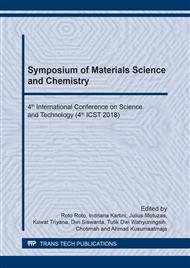[1]
J. Zhang, Q. Tang, X. Xu, N. Li, Development and evaluation of a novel phytosome-loaded chitosan microsphere system for curcumin delivery, Int. J. Pharm. 448 (2013) 168–174.
DOI: 10.1016/j.ijpharm.2013.03.021
Google Scholar
[2]
X. Wang, Y. Jiang, Y.-W. Wang, M.-T. Huang, C.-T. Ho, Q. Huang, Enhancing anti-inflammation activity of curcumin through O/W nanoemulsions, Food Chem. 108 (2008) 419–424.
DOI: 10.1016/j.foodchem.2007.10.086
Google Scholar
[3]
G. Singhvi, M. Singh, Review: In-vitro drug release characterization models, Int. J. Pharm. Stud. Res. 2 (2011) 77–84.
Google Scholar
[4]
A. Sahu, U. Bora, N. Kasoju, P. Goswami, Synthesis of novel biodegradable and self-assembling methoxy poly (ethylene glycol)--palmitate nanocarrier for curcumin delivery to cancer cells, Acta Biomater. 4 (2008) 1752–1761.
DOI: 10.1016/j.actbio.2008.04.021
Google Scholar
[5]
G. Shoba, D. Joy, T. Joseph, M.M.R. Rajendran, P. Srinivas, Influence of piperine on the pharmacokinetics of curcumin in animals and human volunteers, Planta Med. 64 (1998) 353–356.
DOI: 10.1055/s-2006-957450
Google Scholar
[6]
F. Hasanah, Pembuatan Film Kitosan-Pektin dengan Penambahan Emulsifier Asam Stearat sebagai Matriks Pelepasan Kurkumin, Undergraduate Thesis, Department of Chemistry, Universitas Gadjah Mada, Yogyakarta, (2014).
Google Scholar
[7]
H. Octaviani, Studi Pelepasan In Vitro Kurkumin Menggunakan Membran Pektin-Kitosan dengan Emulsifier Asam Palmitat, Undergraduate Thesis, Department of Chemistry, Universitas Gadjah Mada, Yogyakarta, (2015).
Google Scholar
[8]
M. Prabaharan, Chitosan derivatives as promising materials for controlled drug delivery, J. Biomater. Appl. 23 (2008) 5–36.
DOI: 10.1177/0885328208091562
Google Scholar
[9]
A. Anitha, S. Maya, N. Deepa, K.P. Chennazhi, S.V. Nair, H. Tamura, R. Jayakumar, Efficient water soluble O-carboxymethyl chitosan nanocarrier for the delivery of curcumin to cancer cells, Carbohydr. Polym. 83 (2011) 452–461.
DOI: 10.1016/j.carbpol.2010.08.008
Google Scholar
[10]
D. Gopinath, M.R. Ahmed, K. Gomathi, K. Chitra, P.K. Sehgal, R. Jayakumar, Dermal wound healing processes with curcumin incorporated collagen films, Biomaterials 25 (2004) 1911–(1917).
DOI: 10.1016/s0142-9612(03)00625-2
Google Scholar
[11]
P.-H. Chen, T.-Y. Kuo, J.-Y. Kuo, Y.-P. Tseng, D.-M. Wang, J.-Y. Lai, H.-J. Hsieh, Novel chitosan–pectin composite membranes with enhanced strength, hydrophilicity and controllable disintegration, Carbohydr. Polym. 82 (2010) 1236–1242.
DOI: 10.1016/j.carbpol.2010.06.057
Google Scholar
[12]
S. Ghasemi, M.T. Darestani, Z. Abdollahi, B.S. Hawkett, V.G. Gomes, Electrical impedance spectroscopy for determining critical micelle concentration of ionic emulsifiers, Colloids Surf. A Physicochem. Eng. Asp. 441 (2014) 195–203.
DOI: 10.1016/j.colsurfa.2013.09.010
Google Scholar
[13]
P. Severino, S.C. Pinho, E.B. Souto, M.H.A. Santana, Polymorphism, crystallinity and hydrophilic-lipophilic balance of stearic acid and stearic acid--capric/caprylic triglyceride matrices for production of stable nanoparticles, Colloids Surf. B Biointerfaces. 86 (2011) 125–130.
DOI: 10.1016/j.colsurfb.2011.03.029
Google Scholar
[14]
T. Higuchi, Mechanism of sustained‐action medication. Theoretical analysis of rate of release of solid drugs dispersed in solid matrices, J. Pharm. Sci. 52 (1963) 1145–1149.
DOI: 10.1002/jps.2600521210
Google Scholar
[15]
P.L. Ritger, N.A. Peppas, A simple equation for description of solute release II. Fickian and anomalous release from swellable devices, J. Control. Release 5 (1987) 37–42.
DOI: 10.1016/0168-3659(87)90035-6
Google Scholar
[16]
F.-Q. Hu, G.-F. Ren, H. Yuan, Y.-Z. Du, S. Zeng, Shell cross-linked stearic acid grafted chitosan oligosaccharide self-aggregated micelles for controlled release of paclitaxel, Colloids Surf. B Biointerfaces 50 (2006) 97–103.
DOI: 10.1016/j.colsurfb.2006.04.009
Google Scholar
[17]
W. Roth, B. Setnik, M. Zietsch, A. Burst, J. Breitenbach, E. Sellers, D. Brennan, Ethanol effects on drug release from Verapamil Meltrex®, an innovative melt extruded formulation, Int. J. Pharm. 368 (2009) 72–75.
DOI: 10.1016/j.ijpharm.2008.09.052
Google Scholar
[18]
Y. Rosiaux, S. Muschert, R. Chokshi, B. Leclercq, F. Siepmann, J. Siepmann, Ethanol-resistant polymeric film coatings for controlled drug delivery, J. Control. Release 169 (2013) 1–9.
DOI: 10.1016/j.jconrel.2013.04.001
Google Scholar
[19]
D. Patra, F. Sleem, A new method for pH-triggered curcumin release by applying poly (l-lysine) mediated nanoparticle-congregation, Anal. Chim. Acta 795 (2013) 60–68.
DOI: 10.1016/j.aca.2013.07.063
Google Scholar


